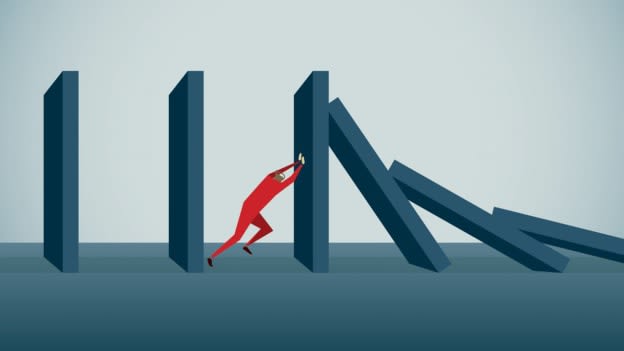Building resilience in COVID-19 times

The COVID-19 pandemic is a human tragedy of potentially biblical proportion and has convulsed societies like never before. Tragically, it has also revealed one particularly shocking thing about our societies and economies: they have been operating on a very thin margin. The edifice seems so shiny: a world of silver jets stitching together gleaming cities, a globe of soaring markets and industrial empires. But a couple of months into coronavirus and it’s all tottering, the jets grounded, the cities silent, and one industry after another heading for bankruptcy. However shiny our world may have seemed, it wasn’t very sturdy. Our systems and society seem to be very fragile, exploding the myths of a robust and resilient order.
We have little control over our environment and the challenges that come our way. But there is always something we can do to soften the impact: we can enhance our ability to handle crisis and cope with adversities. This ability to harness our inner strength to bounce back from setbacks and to thrive during times of challenge or change is known as resilience. Resilience strengthens the state of our mind and our ability to endure and thrive no matter what comes our way
Resilience is an important tool for modern leaders in every field. Those who are actively engaged in building a healthy and just society face unique challenges that often take a deep personal toll. If you lack resilience, you will be vulnerable to stressors like burnout, breakdowns in relationships or death of a loved one. You might feel victimized, harassed, or turn to unhealthy coping mechanisms, such as substance abuse.
While we know that career success can be largely defined by hard work and luck, the ability to work through adversity should never be underestimated. It’s easy to dismiss resilience as something you’re either born with or without. But it can be built with a few simple techniques.
Resilience is however not a fixed trait. It actually grows out of a set of “learnable” behaviors with results that interact to make you less vulnerable to stress. We are all resilient to varying degrees, yet everyone can become even more resilient. We are far more resilient when we are engaged and supported and motivated with and by others. Building strong, positive relationships makes us stronger, happier, more confident—and more resilient to challenge.
While resilience is an essential skill for healthy childhood, adults also can boost resilience in middle age, which is often the time we need it most. Midlife can bring all kinds of highly stressful environments that don’t allow for self-reflection or self-care. Some of the qualities of middle age—a maturity of mind that gives better ability to regulate emotions and a more balanced perspective gained from life’s experiences and concern for future generations—may give older people an advantage over the young when it comes to developing resilience.
Whether you can be said to be resilient or not largely depends on the way you respond as your life unfolds. If you are lucky enough to never experience any sort of adversity or any serious stressors we won’t know how resilient you are. It’s only when you’re faced with hindrances, stress, and other environmental threats that resilience, or the lack of it, can be known.
Resilience won't make your problems go away, but it can give you the ability to see past them. It will help you adapt to difficult situations. When stress, adversity or trauma strikes, you will still experience anger, grief and pain, but you’ll be able to cope with it—both physically and mentally.
The ability to work through adversity should never be underestimated, and resilience can be built with a few simple techniques
Humans possess an extraordinary capacity for adaptation as they are endowed with a natural evolutionary heritage. They have an unprecedented proclivity to alter the ways of life. This is the reason why they have such vast cultural and behavioral diversity. Our fundamental human social, ecological and behavioral adaptability has, over time, enhanced our ability to manage the immediate world, to cushion the impact of the unpredictable, to survive novelty—all through an extraordinary ability to alter the surroundings.
Anyone, anywhere, can initiate change. The guiding mantra can be: “Be the change you wish to see in the world"—which has often been attributed to Mahatma Gandhi. It is nearly more than a century and a half ago that Charles Darwin propounded his theory of evolution. To quote word which many have attributed to him although without reliable confirmation, “It is not the strongest of the species that survive, nor the most intelligent, but the one most responsive to change.” Darwin’s insights into the process of evolution have a direct bearing on the phenomenon of human adaptation that we are talking of, although not in a narrow physical or biological way. Alvin Toffler also cautions with a similar refrain: “The illiterates of the 21st century will not be those who cannot read and write, but those who cannot learn, unlearn, and relearn.”
Adaptability is the only way to ensure the survival of an organism. The assumption that human beings are very special because they have the power, intellect and will to survive in the most trying of circumstances doesn’t stand scrutiny as we have found that life not only survives but thrives in conditions in which human beings cannot possibly survive. How strange it is that the little cockroaches outlived the mighty dinosaurs. Animals learn to adapt and also evolve to cope with the changing environment. Photosynthesis is something natural for the survival of some organisms. But at deep fathomless levels of oceans where there is no sunlight organisms continue to thrive. These are microbial life forms surviving for millions of years, drawing sustenance from minerals and chemicals, tucked away in the dark recesses where there is no light.
What is important for us is how fast we adapt to the changes around us. Instead of dreading change, we must try to find comfort in it. Those who are deeply rooted in traditions are quite likely to be resistant to change. The traditionalists are pessimists about the future and optimists about the past. The temptation to use tradition as a cover for prejudice and conformity, accompanied by a refusal to change or stretch, manifests itself quite stubbornly because it has become our nature. Many refuse to accept that new and creative approaches to finding a solution to problems are possible. Pushed into adopting new ways, they might join hands to ensure that things don’t work. Alan Cohen advises us, “It takes a lot of courage to release the familiar and seemingly secure, to embrace the new. But there is no real security in what is no longer meaningful. There is more security in the adventurous and exciting, for in movement there is life, and in change there is power.”
When we are confronted with unforeseen changes in our lives, our first response may be to either run away from them or fight them. The fear of redundancy is real for those not prepared for change. Fight or flight is an inborn survival instinct that surfaces when we feel threatened. Embracing change with our full being is the only way for us to live mindfully and meaningfully.
How do you respond as your life unfolds? That will reveal how resilient you are. And your resilience can be enhanced through your own behaviors
For the majority of those of middle age, inelasticity comes not of physical muscle and sinew alone, but of mental fiber as well. Experience has its dangers: it may bring wisdom, but it may also bring stiffness and cause hardening of the mind, leading to an inelasticity, which can be crippling for the individual as well as the people around him.
One of the keys to an individual’s success is the ability to adapt to changing situations. “Anicca,” the Pali word for impermanence, is the core of Buddhism. The entire teachings of the Buddha revolve around the fact that nothing stays the same—everything transforms. Albert Einstein emphasizes, “You can’t solve a problem with the same mindset in which it was created.”
Charles Dickens wrote about a prisoner who was locked up for many years in a dungeon. After serving his sentence, he got his freedom. He was brought out from his cell into the bright daylight of the open world. This man looked all around and, after a few moments, was so uncomfortable with his newly acquired freedom that he asked to be taken back to the confines of his cell. To him, the dungeon, the chains, and the darkness were more familiar, secure, and comfortable than accepting the change of freedom and an open world.
Change happens whether we want it to or not. Some people welcome change and find ways to turn the unexpected into an opportunity for growth. Others become frightened and simply react. How we handle the inevitable changes is the key to living a life without fear.















